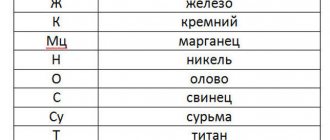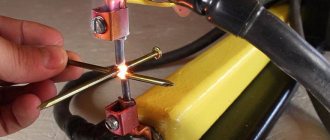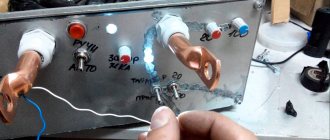Electrodes for resistance welding are designed to supply current to the elements, compress them and remove the generated heat. This part is one of the most important in the equipment, since the ability to process the unit depends on its shape. The stability of the electrode determines the level of welding quality and the duration of continuous operation. Electrodes can be shaped or straight. The production of direct type elements is regulated in the GOST 14111–77 standard.
Shaped parts are characterized by the fact that their axis is offset relative to the cone (seating surface). They are used for welding assemblies and elements of complex shapes that are difficult to reach.
Electrode designs
Electrodes are also used to work with electric arc welding, but they are fundamentally different from the conductive elements for contact welding, and are not suitable for this type of work. Since at the time of welding the parts are compressed by the contact parts of the welding machine, electrodes for resistance welding are able to conduct electric current, withstand compression loads and remove heat.
The diameter of the electrodes determines how firmly and efficiently the parts will be welded. Their diameter should be 2 times thicker than the welded joint. According to state standards, they range in diameter from 10 to 40 mm.
The metal being welded determines the shape of the electrode used. These elements, which have a flat working surface, are used for welding conventional steels. The spherical shape is ideal for joining copper, aluminum, high carbon and alloy steels.
The spherical shape is most resistant to combustion. Due to their shape, they are able to make a larger number of welds before sharpening. In addition, the use of this form allows you to weld any metal. At the same time, if you weld aluminum or magnesium with a flat surface, dents will form.
Electrode diagram for welding
The electrode seat is often cone-shaped or threaded. This design avoids current losses and effectively compresses parts. The landing cone can be short, but they are used with low forces and low currents. If a threaded fastener is used, it is often through a union nut. Threaded fastening is especially important in special multi-point machines, since the same gap between the claws is required.
To perform welding deep into the part, electrodes of a curved configuration are used. There is a variety of curved shapes, so if you are constantly working in such conditions, it is necessary to have a selection of different shapes. However, they are inconvenient to use, and they have lower durability compared to straight ones, so they are used last.
Since the pressure on the shaped electrode is not along its axis, it is subject to bending during heating, and this must be kept in mind when choosing its shape. In addition, at such moments, it is possible that the working surface of the curved electrode may shift in relation to the flat one. Therefore, in such situations, a spherical working surface is usually used. Non-axial load also affects the seat of the electrode holder. Therefore, if there is excessive load, you need to use electrodes with an increased cone diameter.
When welding deep into a part, you can use a straight electrode if you tilt it vertically. However, the angle of inclination should be no more than 30°, since with a greater degree of inclination, deformation of the electrode holder occurs. In such situations, two curved conductive elements are used.
Appearance of electrodes
Using a clamp at the point where the shaped electrode is attached allows you to reduce the load on the cone and extend the service life of the welding machine seat. When developing a shaped electrode, you must first make a drawing, then make a test model from plasticine or wood, and only then begin its manufacture.
In industrial welding, cooling of the contact part is used. Often this cooling occurs through an internal channel, but if the electrode is of small diameter or increased heating occurs, then the coolant is supplied externally. However, external cooling is allowed provided that the parts being welded are not susceptible to corrosion.
The most difficult thing to cool is the shaped electrode due to its design. To cool it, thin copper tubes are used, which are located on the side parts. However, even under these conditions, it does not cool well enough, so it cannot cook at the same pace as a straight electrode. Otherwise, it overheats and its service life is reduced.
Welding in the depths of a small part is carried out with shaped electrodes, and with large parts it is preferable to use shaped holders. The advantage of this method is the ability to adjust the length of the electrode.
During resistance welding, the axis of the two electrodes should be 90° relative to the surface of the part. Therefore, when large-sized parts with a slope are welded, rotary, self-aligning holders are used, and welding is performed with a spherical working surface.
Steel mesh with a diameter of up to 5 mm is welded with a plate electrode. Uniform load distribution is achieved by free rotation of the upper conductive contact around its axis.
Although the spherical shape of the working surface is the most stable of the other shapes, it still loses its original shape due to thermal and power loads. If the working surface of the contact increases by 20% of the original size, then it is considered unusable and must be sharpened. Sharpening of resistance welding electrodes is carried out in accordance with GOST 14111.
Electrode materials for resistance welding
One of the decisive factors in the quality of a weld is tensile strength. This is determined by the temperature of the weld point and depends on the thermophysical properties of the conductor material.
Copper in its pure form is ineffective because it is a very ductile metal and does not have the necessary elasticity to recover to its geometric shape between welding cycles. In addition, the cost of the material is relatively high, and with such properties, the electrodes would require regular replacement, which would make the process more expensive.
The use of hardened copper was also not successful, since a decrease in the recrystallization temperature leads to the fact that with each subsequent weld point the wear of the working surface will increase. In turn, alloys of copper with a number of other metals turned out to be effective. For example, cadmium, beryllium, magnesium and zinc added hardness to the alloy during heating. At the same time, iron, nickel, chromium and silicon allow it to withstand frequent heat loads and maintain the pace of work.
Contact welding
The electrical conductivity of copper is 0.0172 Ohm*mm2/m. The lower this indicator, the more suitable it is as an electrode material for resistance welding.
If you need to weld elements from different metals or parts of different thicknesses, then the electrical thermal conductivity of the electrode should be up to 40% of this property of pure copper. However, if the entire conductor is made of such an alloy, it will heat up quite quickly, since it has high resistance.
By using composite construction technology, significant cost savings can be achieved. In such designs, the materials used in the base are selected with a high electrical conductivity, and the outer or replaceable part is made of heat and wear-resistant alloys. For example, metal-ceramic alloys consisting of 44% copper and 56% tungsten. The electrical conductivity of such an alloy is 60% of the electrical conductivity of copper, which allows heating the weld point with minimal effort.
Depending on the working conditions and assigned tasks, alloys are divided into:
- Difficult conditions. Electrodes operating at temperatures up to 500 °C are made of bronze, chromium and zirconium alloys. For welding stainless steel, bronze alloys alloyed with titanium and beryllium are used.
- Average load. Welding of carbon, copper and aluminum parts is usually carried out using electrodes made of alloys, in which the grade of copper for the electrodes is capable of operating at temperatures up to 300 °C.
- Lightly loaded. Alloys, which include cadmium, chromium and silicon-nickel bronze, are capable of operating at temperatures up to 200 ° C
Features of the welding process
When spot welding, a short-term pulse of electric current is applied to the junction of metal parts, the duration of which varies within 0.01-0.1 seconds.
In this case, in the area where the electrodes are applied, the edges of the products melt and acquire a common core. After applying current, the parts are cooled under pressure to crystallize this core, as well as to cool it completely.
Technical data of resistance welding machines.
Main methods of resistance welding:
- point method;
- suture or roller method;
- butt contact welding.
The peculiarities of this type of welding are that it does not require increased safety measures. Pressing the parts against each other leads to the formation of a sealing belt between them without a splash of molten metal.
But the pressure should be removed from the parts with some delay in order to ensure better crystallization, forging and elimination of inhomogeneities.
The advantages of spot welding are cost-effectiveness, high mechanical strength of seams, and the ability to automate work processes. The disadvantages of resistance welding are the lack of tightness of the created welding seams.
Preliminary preparation will ensure high quality welds. Parts are cleaned of all types of contaminants using special brushes, sandblasting, acid etching, and other methods.
It is important to perform the assembly before welding in such a way that it ensures an accurate and tight fit of the metal products to each other.
Otherwise, the gap between the parts will reduce and absorb part of the pressure on them, the sedimentary pressure will decrease, and a scatter in the strength of the weld points will appear. In general, this will reduce the strength characteristics of the weld and make it vulnerable to negative external factors.
Electrodes for spot welding
The spot welding process explains itself from its name. Accordingly, a mini welding seam is one point, the size of which is determined by the diameter of the working surface of the electrode.
Electrodes for resistance spot welding are rods made of alloys based on copper. The diameter of the working surface is determined by GOST 14111-90, and is manufactured in the range from 10-40 mm. Electrodes for spot welding are carefully selected because they have different properties. They are made with both spherical and flat working surfaces.
Curved electrode for spot welding
Electrodes for spot welding with your own hands can theoretically be made, but you need to be sure that the alloy meets the stated requirements. In addition, you need to maintain all sizes, which is not so easy at home. Therefore, when purchasing factory-made conductive elements, you can count on high-quality welding work.
Spot welding has a lot of advantages, including an aesthetic weld spot, ease of operation of the welding machine and high productivity. There is also one drawback, namely the lack of a sealed weld seam.
Results
The use of resistance welding from an inverter with your own hands allows you to connect metals and alloys of different grades using a high temperature electric current, which provokes plastic deformation of the contact zone of parts when they are compressed.
Resistance welding technology has a wide range of applications: it is actively used in everyday life and on an industrial scale in the manufacture of large batches of the same type of metal products.
It is important to follow the technology, put the resistance welding designation on the diagram, use the electrodes recommended by the manufacturer, select the correct operating modes of the unit, then the welds will acquire high quality and durability.











